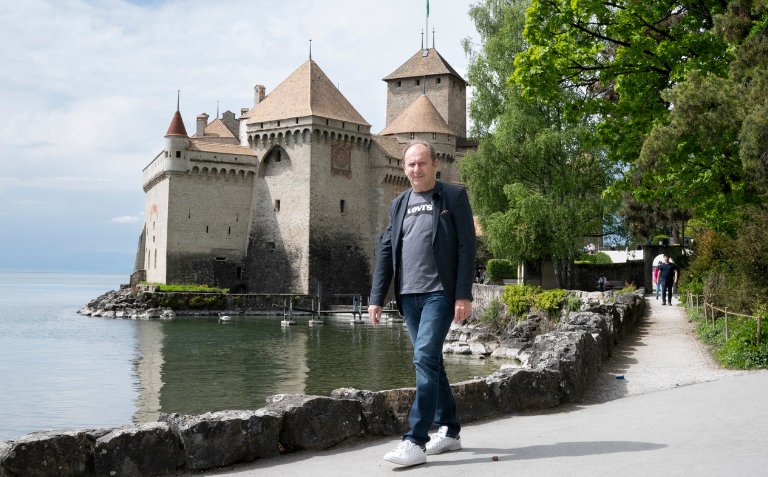
An implant to restore walking in Parkinson’s patients
Share this article
Neuroscientists and neurosurgeons from EPFL/CHUV/UNIL, Inserm and the University of Bordeaux have designed a neuroprosthesis to correct the gait disorders associated with Parkinson’s disease. In a study published in Nature Medicine, the scientists detail the development process of the neuroprosthesis which enabled them to treat a first patient suffering from Parkinson’s disease, enabling him to walk with fluidity, confidence and without falling.
Disabling gait disorders occur in around 90% of people with advanced Parkinson’s disease. These gait disorders are often resistant to currently available treatments. Marc, aged 62, has been living with Parkinson’s disease for almost three decades. His tremors and rigidity were treated with dopamine, followed by deep brain stimulation in 2004. More recently, he developed severe gait disorders that did not respond to dopamine or brain stimulation. “I could hardly walk without frequent falls, several times a day. In certain situations, such as entering an elevator, I would stomp on the spot, freezing, as they say.”
Electrical stimulation of the spinal cord
“The idea of developing a neuroprosthesis that electrically stimulates the spinal cord to harmonize gait and correct locomotor disorders in Parkinson’s patients is the fruit of several years’ research into the treatment of paralysis caused by spinal cord lesions,” explains Grégoire Courtine, Professor of Neuroscience at EPFL, CHUV and UNIL. Unlike conventional treatments for Parkinson’s disease, which target brain regions directly affected by the loss of dopamine-producing neurons, this neuroprosthesis targets the area of the spinal cord responsible for activating leg muscles during walking, and which is a priori not directly affected by Parkinson’s disease.
“It’s impressive to see that by targeted electrical stimulation of the spinal cord, in the same way as we have done with paraplegic patients, we can correct the walking disorders caused by Parkinson’s disease”, notes neurosurgeon Jocelyne Bloch, professor at CHUV, UNIL and EPFL, and co-director of the NeuroRestore center with Grégoire Courtine.
The implantation of this neuroprosthesis in a patient would not have been possible without the collaboration of Dr Erwan Bezard, an Inserm neuroscientist affiliated with the CNRS and the University of Bordeaux, who has devoted his career to understanding neurodegenerative diseases. His expertise in preclinical models of Parkinson’s disease has been essential in driving the technological and conceptual developments required for clinical application in humans.
“Even the stairs don’t scare me anymore”.
Two years ago, the team of scientists and doctors was ready and the first patient underwent surgery, in Lausanne at the CHUV. After precision neurosurgery, Marc, from Bordeaux, was fitted with this new neuroprosthesis consisting of a field of electrodes placed against the area of his spinal cord that controls walking, and a generator of electrical impulses implanted under the skin of his abdomen. Thanks to targeted programming of the spinal cord stimuli, which adapt in real time to his movements, Marc’s walking difficulties rapidly subsided. After a few weeks’ rehabilitation with the neuroprosthesis, he was able to walk almost normally again. Today, he uses his neuroprosthesis for around 8 hours a day, turning it off only when he’s sitting down for a long period or when he’s asleep: “I turn the stimulation on in the morning and off at night. It allows me to walk better, to stabilize myself. Even the stairs don’t scare me anymore. Every Sunday I go to the lakeside and walk about 6 kilometers. It’s great.
The challenge of large-scale deployment
This neuroprosthesis opens up new prospects for treating the walking disorders from which many people suffering from Parkinson’s disease suffer, but at this stage, this therapeutic concept has demonstrated its effectiveness in a single person, with an implant that still needs to be optimized for large-scale deployment. In partnership with ONWARD Medical, Grégoire Courtine and Jocelyne Bloch are working on the development of a commercial version of the neuroprosthesis, incorporating all the functions required for optimal daily use. “Our ambition is to make this innovative technology widely available, so as to significantly improve the quality of life of Parkinson’s patients around the world”, they explain.
New clinical trials in 2024
In addition, thanks to a generous donation of $1 million from the Michael J. Fox Foundation for Parkinson’s research, NeuroRestore will initiate clinical trials on six new patients starting next year. The aim of these trials is not only to validate the technology developed in collaboration with ONWARD, but also to identify the patient profiles most likely to benefit from this innovative therapy. Founded by actor Michael J. Fox (“Back to the future”), who himself suffers from Parkinson’s disease, this foundation is the leading private donor in the field of Parkinson’s research.
Moreover, neurosurgeon Jocelyne Bloch and professor at CHUV, UNIL and EPFL, and co-director of the NeuroRestore center Grégoire Courtine won in 2023 the BioAlps Academia Award.
Source: CHUV Press Release
📸 Marc, the first patient to benefit from the new implant to treat Parkinson’s disease.